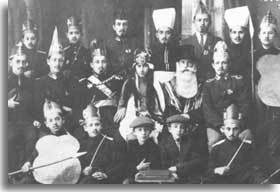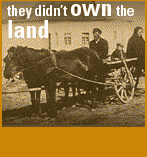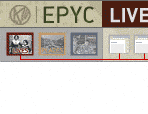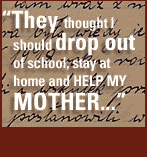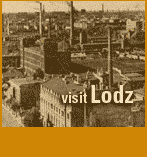

About the Jewish Calendar : Holidays
The Jewish calendar is a guiding structure for Jewish life. It evokes and informs the rhythms of Jewish historical memory, thought and traditions. Holidays embody and represent important Jewish history and cultural moments and messages. Each has its own folklore expressed in food, music, and traditions. Each holiday is different in its content, its expression, in its prayers and even in the melodies sung during the festivities. The specific foods associated with a commemoration are evocative of the history behind the holiday, as is the oil used in Chanukah latkes (potato pancakes), or have secondary associations that are conjoined tradition, such as the use of the esrog (lemon) for the Feast of Tabernacles (Sukkot) that occurs at the time of harvest. An enormous variety of experiences and ideas are evoked by Jewish holidays, and these need to be explored.
Here is a sample of some of the traditions surrounding a few major Jewish Holidays:
Purim  : The holiday commemorating the saving of the Jews in Persia from potential destruction, is a time when Jews read the megillah
: The holiday commemorating the saving of the Jews in Persia from potential destruction, is a time when Jews read the megillah  of Esther, a text written on a scroll that tells the story and reasons for the celebration. While much anger is evoked by the name of Haman during the reading (he was the potential destroyer of the Jews), and gragers (rattles) or foot stomping mark his memory, the day is a celebration! In a playful mode, Yiddish children's songs like "Yakhne-Dvoshe fort in shtot" (Yakhne-Dvoshe goes to town) were sung as youngsters ran and visited each other, ate homentashn (specially shaped poppy seed cookies), and dressed up as the historical characters of the story. The joyous atmosphere also affected the more contained adult world as well, producing carnival-like expressions of gaiety.
of Esther, a text written on a scroll that tells the story and reasons for the celebration. While much anger is evoked by the name of Haman during the reading (he was the potential destroyer of the Jews), and gragers (rattles) or foot stomping mark his memory, the day is a celebration! In a playful mode, Yiddish children's songs like "Yakhne-Dvoshe fort in shtot" (Yakhne-Dvoshe goes to town) were sung as youngsters ran and visited each other, ate homentashn (specially shaped poppy seed cookies), and dressed up as the historical characters of the story. The joyous atmosphere also affected the more contained adult world as well, producing carnival-like expressions of gaiety.
Passover  : The special Seder
: The special Seder  meal is structured around the reading of the Haggadah, a liturgical text that retells the biblical story of the Israelites gaining freedom from Egypt. Various melodies are used for the recitation of the Haggadah story, and many of its songs are well known: Dayyenu ("It would have been enough"), Chad Gadya ("An only kid"), and piyyutim (poems) like Ma Nishtanah, which explain why the Seder night is different from all other nights of the year. Each of these pieces together make the holiday unique. The text read at the family table offers an opportunity for dialogue between the generations, for analysis and for education. The content is rich for the Passover holiday; there are many rules and regulations pertaining to food and household activity, as well as many varied traditions that make the week of the holiday a whole family experience, one that connects people not just to the historical messages, but to a variety of ongoing group traditions, including music and games, that foster ethical and philosophical explorations within the family.
meal is structured around the reading of the Haggadah, a liturgical text that retells the biblical story of the Israelites gaining freedom from Egypt. Various melodies are used for the recitation of the Haggadah story, and many of its songs are well known: Dayyenu ("It would have been enough"), Chad Gadya ("An only kid"), and piyyutim (poems) like Ma Nishtanah, which explain why the Seder night is different from all other nights of the year. Each of these pieces together make the holiday unique. The text read at the family table offers an opportunity for dialogue between the generations, for analysis and for education. The content is rich for the Passover holiday; there are many rules and regulations pertaining to food and household activity, as well as many varied traditions that make the week of the holiday a whole family experience, one that connects people not just to the historical messages, but to a variety of ongoing group traditions, including music and games, that foster ethical and philosophical explorations within the family.
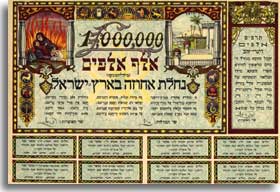

Rosh Hashanah  : The holiday marking the New Year and the beginning of the Jewish calendar is also the holiday during which each person begins an introspective assessment of his or her own actions and behavior. This is a time for a new beginning for each Jew. The Rosh Hashanah liturgical prayers said in the synagogue are familiar and recognized by the whole Jewish world. Perhaps it is the shofar (the hollowed ram's horn) that is the most specific and familiar musical instrument of this holiday. The custom is to blow it 100 times on each day of Rosh Hashanah. The person who blows the shofar is known as the ba'al Tokeah.
: The holiday marking the New Year and the beginning of the Jewish calendar is also the holiday during which each person begins an introspective assessment of his or her own actions and behavior. This is a time for a new beginning for each Jew. The Rosh Hashanah liturgical prayers said in the synagogue are familiar and recognized by the whole Jewish world. Perhaps it is the shofar (the hollowed ram's horn) that is the most specific and familiar musical instrument of this holiday. The custom is to blow it 100 times on each day of Rosh Hashanah. The person who blows the shofar is known as the ba'al Tokeah.
The shofar is intended as a reminder of Abraham's courageous willingness to sacrifice Isaac, his only son, in the famous Torah passage known in Yiddish as the akeyde (the binding), as well as a reminder of the creation of the world. Moreover , blowing the shofar serves as a reminder that a parent need never again sacrifice a child to prove faith. At the moment that Abraham was set to slaughter his son, in what was at the time an extreme but acceptable behavior within many cultures (i.e., Iphigenia in Greek mythology), an angel descended from heaven and told Abraham to cease, that God no longer demanded this immense sacrifice. At that moment, a ram appeared entangled in the bushes nearby and Abraham substituted it as the offering he had come to make.
Each holiday is infused with historical content to which it gives expression, with specific folklore, food, and music associated with the festivities. A world of messages and meanings spring up from similar explorations into other Jewish holidays; all share an underlying theme of striving for individual ethical growth and responsibility, and of God's love for the Jewish people.






